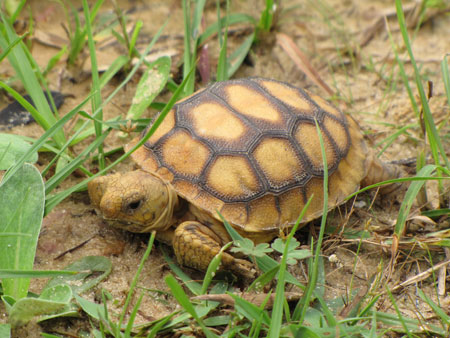By Michelle Werts

When you read the words forests and wildlife, I’m sure the first visions that pop into your head are pictures of deer foraging in the understory, squirrels running up trunks and birds flitting in the canopy. Forests, though, aren’t home just to our mammalian and avian friends. What would your reaction be if I told you that certain species of tortoises require forests to survive?
Shocking, yes? Only four tortoise species are found in North America, and one them, the gopher tortoise, is particularly fond of longleaf pine trees. Gopher tortoises make their homes, or burrows, in the deep, well-drained soils around longleaf pine trees. Over the course of their 50-60 year life, they’ll live in multiple burrows, and when they abandon one, other wildlife quickly claim the remnants for their own purposes. Gopher tortoises also feed on grasses and plants in the area, helping with seed dispersal. These are just two of the reasons that the gopher tortoise is considered a keystone species in America’s southeast.
Unfortunately, longleaf pine forests have been disappearing over the centuries. Four hundred years ago, America’s southeast had 60-90 million acres of longleaf pine forest, and now, only a few million acres remain. As the forests have gone, so have the tortoises: They’re now listed as threatened under the Endangered Species Act.
Gopher tortoises aren’t alone in their plight, as our forests are full of wildlife species that rely on forests to survive and have been affected by their destruction:

- Hundreds of years ago, grizzly bears numbered in tens of thousands. Now, less than 1,400 remain in the wild, and one of their primary food sources, whitebark pine seeds, are rapidly disappearing in the West due to blister rust and mountain pine beetle infestation.
- Red-cockaded woodpeckers, like the gopher tortoise, rely on longleaf pine to build their homes and are also endangered because of habitat loss. Like the tortoise, their abandoned homes make good homes for other species as well.
- Jaguarundi, a slender-bodied wild cat, has seen its brushland, lightly wooded habitat in Texas decreased by 90 percent, and it’s been endangered for the last 25 years.
Because of the strong benefits that forests provide for wildlife, from shelter to food, dozens of our Global ReLeaf projects each year focus on restoration efforts for wildlife. Plus, our policy team advocates for forest issues that are of particular importance to our furry, winged, hard-shelled and scaly friends. To find out more about the connections between forests and wildlife, how we’re working to help and how you can help, too, visit our Forests & Wildlife Habitat page.